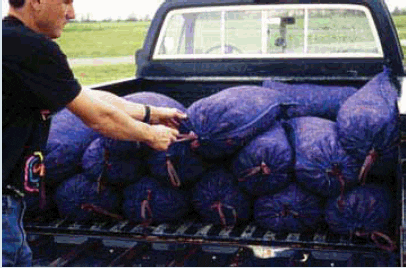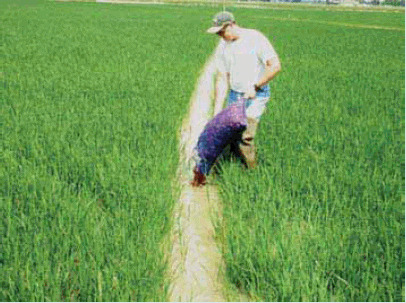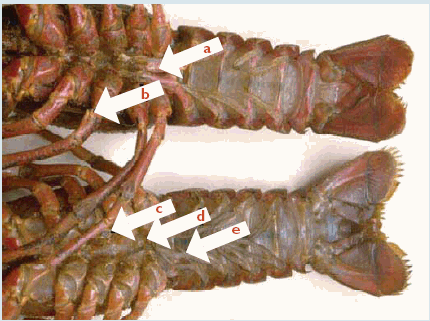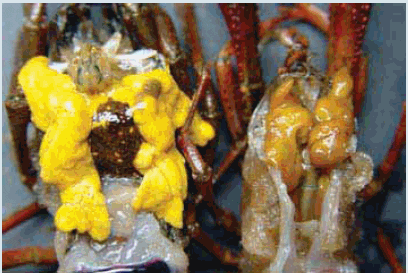Crawfish aquaculture relies on natural reproduction of resident or stocked adults to populate the ponds. Yields of harvestable animals within a season depend on broodstock survival, successful reproduction and survival of offspring. In established ponds, however, where production occurs in the same location each year, crawfish populations are usually self-sustaining with no need for supplemental stockings, short of some major catastrophe that interrupts the normal life cycle, such as a major die-off (from pesticides or other contaminates) prior to successful burrowing. Once a pond is established, subsequent crawfish crops rely on holdover broodstock from a previous cycle. This reliance is possible because harvesting operations are inefficient, allowing significant “carry over” of unharvested individuals from year to year, even under the most intensive harvesting efforts.
Since crawfish populations tend to be self-sustaining, stocking is usually only needed in new ponds, when a pond has been idle for a season or longer or after extensive levee renovation or other events that disrupt the reproductive process in permanent ponds. Stocking of new ponds is usually necessary, unless it is known beforehand that sufficient numbers of crawfish of the right species are present to serve as broodstock. When a pond is idle for at least a season and remains dry for much of that time, crawfish broodstock mortality may increase and/or reproductive processes may be hampered to the point that restocking is needed.
Restocking is often needed following major levee renovation because the most productive broodstock are usually burrowed into the levees in open ponds, and earth moving will often destroy broodstock within their burrows or prevent reemergence in the fall. Sometimes repair or renovation of existing levees is unavoidable, but if done on a large scale during the interval between crawfish burrowing in spring or early summer and reproduction during the fall, restocking will likely be needed. Unfortunately, restocking may not always be possible before the next production season. Severe drought conditions during the critical reproductive period (July to October in the South) also can impair reproduction.
Field rotational methods for crawfish aquaculture do not normally allow for crawfish populations to reach high densities. To ensure adequate numbers of broodstock in a pond that has been out of production for one or more seasons, rotational ponds are usually stocked annually. For the most part, population control is one of the most difficult aspects of crawfish production due to, in part, factors that are not under the producer’s control. Many factors associated with stocking practices, however, do fall under the control of a pond manager and can greatly influence production outcomes during the subsequent season. Research has indicated that broodstock survival and reproductive success following stocking can be highly variable, though many of the reasons are still unidentified.
Species and Size
Producers in Louisiana should stock only red swamp crawfish because of their high fecundity and preference in the marketplace. In areas with no marketing concerns over white river crawfish, some mixture of reds and whites is acceptable. Size of mature broodstock is of little concern because, although larger crawfish produce a higher number of young, fewer crawfish are purchased per pound of broodstock. Smaller crawfish produce fewer young on average, but more crawfish are purchased per pound. Therefore, total recruitment potential is similar regardless of the size of the broodstock used. Yet, smaller crawfish are sometimes sought because their price per pound is usually lower. Some anecdotal evidence suggests that small, mature broodstock may be hardier than very large adults, but this has yet to be verified.
Dates
New ponds in a monocropping system are usually stocked between April and July when broodstock sources contain a high percentage of sexually mature individuals with at least some advanced ovarian development. Cost of broodstock is sometimes an important variable when decisions to stock are made, with prices usually lowest near the end of the harvest season. Stocking should follow all major levee work, most notably when levees provide the only exposed ground in a flooded pond. Crop rotational systems that employ the field rotation approach are usually stocked in late May, in June or July, when rice plants are large enough to withstand the crawfish without damage and when most needs for harmful pesticide applications have passed – about 45 days post-planting.
Habitat
Crawfish broodstock are obtained from a variety of habitats (monoculture ponds, rotational ponds and the wild crawfish fishery) and from a wide array of conditions within each of those habitats. Research has not shown a strong link between habitats broodstock may be collected from (say, farmed versus wild) and their survival or reproductive success. It is likely, though, that the environmental conditions within habitats where breeding stock is obtained, such as water temperature, quality and quantity of nutritional resources, crowding and other factors are responsible for much of the variability in reproductive success. Suitable broodstock can be obtained from any type of pond or natural habitat as long as the crawfish are in good health and not under undue stress. Common stressors in any habitat are related to elevated temperatures, low oxygen, poor nutrition and overcrowding, including overcrowding inside traps prior to harvest.
Vegetative cover within the pond being stocked plays an important role in broodstock survival. Although daily nutritional needs are easily met after stocking (because of low densities of crawfish stocked), vegetative cover serves to protect stockers from predators and cannibalism and may serve to buffer the pond temperature. Many types of vegetation also provide access to the surface in times of low oxygen. Vegetation, or some other form of cover, along the water’s edge also provides protection from predators while brood crawfish are constructing burrows. If levee surfaces are completely bare and devoid of cover, artificial cover, such as cardboard, plywood, clumps of hay or corrugated roofing material strategically placed along the perimeter near the water’s edge will enhance successful burrowing.
Pond water temperature during and after stocking can also be a critical factor. Crawfish cannot tolerate water temperatures over 92 F to 95 F for long periods. Crawfish may seek deep or shaded areas of the pond, if available, to avoid the extreme temperature of midday, but if refuges are unavailable, crawfish will simply leave the pond or die. Increased water depth, vegetative cover and shade, or water exchanges are all options for buffering the effects of high water temperatures at stocking.
Handling
Proper handling of broodstock is also critical for best results. Care should be taken to limit the amount of time broodstock remain in the trap prior to harvest and in storage and transit after harvest. Lengthy exposure to elevated temperatures, direct sunlight or wind will kill or severely stress broodstock, as will rough handling or contamination with foreign substances such as fuel or chemicals (Figure 1). Crawfish should be kept clean, moist and at temperatures between 60 F and 80 F. These practices are best accomplished by shading (with tarps, burlap or other suitable materials) and wetting sacks of crawfish periodically. Broodstock should not be kept in refrigerated coolers or completely iced down. Limited use of ice, however, may be a suitable means of controlling temperature and moisture during transport. Harvesting or transporting crawfish broodstock at dawn, dusk or night is also a suitable means of reducing stress. Always exercise caution when handling the animals. Excessive or rough handling can lead to crushing or cracking of the delicate exoskeleton, raising mortality.

Conditions under which crawfish are introduced to the pond are also critical. Contrary to rumor, crawfish should always be emptied directly into the water and not onto dry ground adjacent to the water (Figure 2). Because crawfish are mobile, there is no need to equally disperse them over the entire pond or even around the entire perimeter, but some dispersal may be necessary in large fields. However, crawfish should be stocked into each section or segment of a divided pond. Best results are achieved when water temperatures do not differ greatly from the temperature of the crawfish themselves at the time of stocking. Therefore, stocking during the cooler hours of the day/night or during cloudy/rainy weather is one way to minimise this difference and maximise survival.

Rates
Stocking rates are based primarily on anecdotal evidence, pertinent factors affecting successful survival and burrowing and, to some extent, personal preference. Recommended stocking rates vary depending on the number of native crawfish present and the amount of cover around and within the pond. Amount and type of cover, such as vegetation in the pond and at the water’s edge often will affect the number of crawfish surviving and successfully burrowing after stocking. Stocking rates of 50 lb/ac to 60 lb/ac are recommended for areas lacking native crawfish and with sufficient cover to protect stocked crawfish from predators (both in the pond and while burrowing).
Stocking rates may be decreased from these general recommendations when healthy populations of native crawfish are present. Similarly, they should be increased when conditions make for poor survival following stocking or when burrowing is hazardous due to predators or inclement weather. Although not well documented, it is possible that effective stocking rates may be lowered somewhat when stocking occurs in ponds with permanent levees that already have many old or existing burrows.
In very large ponds with flat bottoms and few interior levees, effective stocking rates may be limited by the amount of linear levee surface around the pond. When the ratio of pond surface area becomes exceedingly large compared to linear levee, available burrowing area at the water’s edge may be limited, thereby necessitating lower stocking rates. Simply put, not enough levee is available for crawfish to burrow into. Anticipated weather patterns after stocking also may influence desired stocking rates. Successful burrowing depends on critical moisture levels in the soil. Drought makes for poor burrowing by lowering water levels and drying out the levees. Frequent rainfall helps stabilise water levels and makes burrowing easier for the crawfish, possibly even allowing burrow excavation away from the water’s edge. In short, stocking recommendations of 50 lb/ac to 60 lb/ac are only general recommendations – many producers elect to stock up to 80 lb/ac or more when post-stocking survival is unpredictable. Producers should weigh all of the factors in their given situation and adjust stocking rates accordingly.

Sex Ratio and Condition of Broodstock
The sex ratio and condition of crawfish broodstock both are important. At least 50 per cent of the crawfish used as stockers should be females (Figure 3). The percentage of females can be higher, but percentage of males should not be higher than females. Healthy males can mate with more than one female. Quality crawfish broodstock also should have an outwardly healthy appearance and be highly active at normal temperatures.
Under typical stocking conditions, most of the broodstock should be sexually mature, especially if environmental conditions in the new ponds are poor (little food or shelter, poor water quality, high temperatures, etc.) or the pond must be drained soon after stocking. If pond conditions or water levels deteriorate soon after stocking, it is desirable that crawfish be able to begin burrowing shortly after introduction. The goal of broodstock management is for crawfish to start burrowing on their own (for reproductive purposes) when they have reached maturity and mated, rather than being forced to burrow for survival purposes because of pond drainage. Therefore, under less than ideal conditions, it is desirable to stock crawfish that are nearly all mature at the time of stocking.
Conversely, if new ponds have optimal temperatures and oxygen levels, contain sufficient cover to minimise predation and can maintain these conditions for an extended period after stocking, it may be desirable to stock with younger crawfish that are not closely synchronised in their state of maturity. Under favorable conditions, “pre-adult” crawfish can mature and mate in the new pond following stocking, and a mixture of younger and more mature crawfish at stocking might extend the effective spawning period over more months in the subsequent production season. An increased spawning period increases chances of successful reproduction and recruitment under unpredictable conditions before and after flooding, such as drought, hurricanes, delayed flood-up or other events that might interfere with normal recruitment. Nonetheless, for the most predictable results, at least half of the crawfish at stocking should be sexually mature.
In addition, when stocking occurs during summer, at least some portion of the mature females should show signs of ovarian development. Mature females possess yellowish to tan, or even darker eggs. The optimal percentages of crawfish with advanced ovarian development and the optimal stages of development at stocking have not been determined and probably vary from situation to situation.
As with any species, reproduction calls for nutritional needs beyond those required for body maintenance or even growth. Crawfish need to have enough stored energy reserves prior to burrowing not only for survival during the long burrow confinement, but also for the reproductive processes that occur in the burrow, where additional food resources are limited or nonexistent. Crawfish used for broodstock should possess adequate nutritional reserves prior to stocking or be able to acquire what is needed following stocking but prior to burrowing. Hence, aside from exhibiting signs of egg development, suitable stocker crawfish also should possess signs of adequate energy reserves in the hepatopancreas (or “fat”), the main energy storage organ (Figure 4). The hepatopancreas of dissected crawfish should appear full and fatty and golden or yellow, but not brown, green or watery looking, which indicates poor nutrition and body condition. Examination of a few dissected individuals from each population of crawfish stocked is the preferred way to estimate body condition and reproductive stage.
Preliminary evidence suggest that, in some cases, supplemental feeding of ponds prior to harvesting crawfish for broodstock may improve body condition and increase the reproductive performance of the stockers. Predictable, cost effective feeding protocols, however, have not yet been developed. Furthermore, given an adequate period from stocking to burrowing of several or more weeks in a new pond or rice field, crawfish may be able to gain sufficient energy reserves in the relatively food-rich environment without the use of supplemental feeds.

Post-stocking Recommendations
To achieve maximum results, stocked crawfish must survive and, if necessary, complete maturity, increase their energy reserves, mate and then burrow successfully. Therefore, environmental conditions in the pond should be maintained to support this process for the maximum number of stockers. This means water temperature and oxygen should remain within acceptable ranges, and water levels should remain relatively constant. Water replacement and/or flushing may be necessary. To provide crawfish every opportunity to burrow successfully and in optimal conditions, water should remain on the field as long as possible, or feasible, after stocking.
Premature draining can prevent some crawfish from reaching the desired state of maturity and/or condition, and also can make burrowing more difficult or impossible. Fluctuating water levels, especially in the absence of timely rains, also can hinder proper burrowing. Unchecked predators, especially fish and birds, can significantly reduce numbers of broodstock, and extensive levee work following burrowing can further reduce survival, reproduction and recruitment. Therefore, attention given to ponds after stocking is as important as other factors relating to the practice of stocking brood crawfish in new or idle ponds.
Summary
To ensure maximum benefits and achieve the most return for dollars spent while minimising risks, care should be taken to optimise a stocking strategy. Receiving ponds should be completed and readied for animals in advance of stocking with adherence to recommendations for water quality, cover and predator control. All, or in some cases, most of the crawfish to be stocked should be red swamp crawfish, and the stocking rate should be carefully determined based on all applicable factors, including personal experiences for a particular geographical location and habitat. To prevent the proverbial “all the eggs in the same basket” syndrome, consider stocking any given pond on more than one date within an acceptable time frame and with crawfish from more than one source. Furthermore, mixing females with varying maturity/egg stages, depending on when ponds are stocked and the length of time ponds will remain flooded after stocking, will aid in expanding effective spawning dates and lessen potential setbacks from unforeseen circumstances.
Stocking should be done with healthy animals of the proper ratio of females possessing a high level of energy reserves and proper handling during and after harvest. If possible, stocking should accompany rainy weather and/or occur when pond temperatures are the lowest in the day. Pond levels should remain mostly constant, at near normal depths, until a week or so before draining, when water level can be dropped substantially and held at that level until final draining to trigger last-minute burrowing. Ponds should remain flooded for as long as possible or practical following stocking. Lastly, hold levee disturbances during summer to a minimum. The initial stocking of brood crawfish is one of the least costly components of farming crawfish. Any attempt to “save” money by purchasing poor quality broodstock or failure to follow recommended stocking protocols will invariability be very expensive to the producer if reproductive failure is the result.
Stocking Guidelines
- New or idle crawfish ponds should be stocked with approximately 50 to 60 pounds of crawfish per acre.
- Add more if pond (or crawfish) conditions are questionable, and less if crawfish are already present.
- Stock healthy crawfish (sacrificed individuals generally have bright yellow fat).
- Be sure at least 50 per cent are females
- Be sure at least 50 per cent of females are mature (sacrificed individuals will have yellow to brown eggs).
- Don’t be concerned about individual size, or origin of stock, as long as the crawfish are mature and healthy.
- Red swamp crawfish only, from more than one source, is preferred.
- Stocking over several days is preferred.
- Do not use crawfish that were stored in a cooler.
- May to June is the preferred time to stock, although stocking in July may be possible under the proper conditions.
- Move crawfish as fast as possible to the pond; keep wet and shaded.
- Stock all sections of the pond and place crawfish directly in the water, not on dry ground.
- Do not drain fields for at least 2 or 3 weeks after stocking.
March 2010


